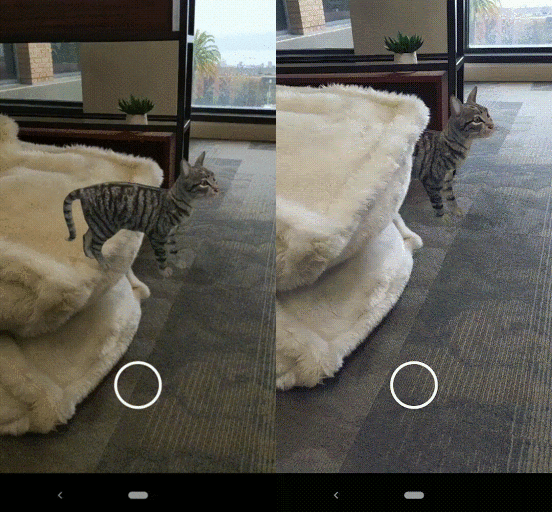Posted by Rajat Paharia, Product Lead, AR Platform
Since the launch of ARCore, our developer platform for building augmented reality (AR) experiences, we've been focused on providing APIs that help developers seamlessly blend the digital and physical worlds.
At the end of last year, we announced a preview of the ARCore Depth API, which uses our depth-from-motion algorithms to generate a depth map with a single RGB camera. Since then, we’ve been working with select collaborators to explore how depth can be used across a range of use cases to enhance AR realism.
Today, we're taking a major step forward and announcing the Depth API is available in ARCore 1.18 for Android and Unity, including AR Foundation, across hundreds of millions of compatible Android devices.
Generate a depth map without specialized hardware to unlock capabilities like occlusion
As we highlighted last year, a key capability of the Depth API is occlusion: the ability for digital objects to accurately appear behind real world objects. This makes objects feel as if they’re actually in your space, creating a more realistic AR experience.
Illumix, the game studio behind Five Nights at Freddy’s AR: Special Delivery, uses occlusion to deepen the realism of the experience by allowing certain characters to hide behind objects for more startling jump scares.

Play Five Nights at Freddy’s AR: Special Delivery
While occlusion is an important capability, the ARCore Depth API unlocks more ways to increase realism and enables new interaction types. The ARCore Depth Lab spurred more ideas on how depth can be used, including realistics physics, surface interactions, environmental traversal, and more. Developers can now build on these ideas through the open sourced GitHub project.

Experiment with ARCore Depth Lab on the Google Play Store
The designers and engineers at Snap Inc. integrated several of these ideas into a set of Snapchat Lenses including the Dancing Hotdog and a new Android exclusive Undersea World Lens.
See how depth can add a layer of realism to your Snapchat experience
Snapchat Lens Creators can now download an ARCore Depth API template to create depth-based experiences for compatible Android devices. Sam Hare, Research Engineering Manager at Snap Inc, expressed his excitement, “We’re beginning to understand what kinds of depth capabilities are exciting for developers to build with. This single integration point streamlines and simplifies the development process and enables Lens Studio developers to easily take advantage of advanced depth capabilities.”
Another app that combines occlusion with other depth capabilities is Lines of Play, an Android experiment from the Google Creative Lab. Lines of Play lets users create domino art in AR, and uses depth information to showcase both occlusion and collisions. Design elaborate domino creations, topple them over and watch them collide with the furniture and walls in your room.

Watch as domino pieces topple into each other and onto your walls with Lines of Play
In addition to gaming and self-expression, depth can also be used to unlock new utility use cases. For example, the TeamViewer Pilot app, a remote assistance solution that enables AR annotations on video calls, uses depth to better understand the environment so experts around the world can more precisely apply real time 3D AR annotations for remote support and maintenance.

3D annotations help experts accurately highlight details in the TeamViewer Pilot app
Later this year, you will be able to try more depth-enabled AR experiences such as SKATRIX by Reality Crisis and SPLASHAAR by ForwARdgames, that use surface interactions and environmental traversal as they make rich use of the environment around you.
Check out surface interactions and environmental traversal in SKATRIX, and SPLASHAAR
While depth sensors, such as time-of-flight (ToF) sensors, are not required for the Depth API to work, having them will further improve the quality of experiences. Dr. Soo Wan Kim, Camera Technical Product Manager at Samsung commented on the future that the Depth API and ToF unlocks saying, “Depth will enrich user's AR experience in many perspectives. It will reduce scanning time, and can detect planes fast, even low textured planes. These will bring seamless experiences to users who will be able to use AR apps more easily and frequently.” In the coming months, Samsung will update their Quick Measure app to use the ARCore Depth API on the Galaxy Note10+ and Galaxy S20 Ultra.

Accurately measure with Quick Measure
To learn more and get started with the ARCore Depth API, get the SDK and visit the ARCore developer website.






 Posted by Shahram Izadi, Director of Research and Engineering
Posted by Shahram Izadi, Director of Research and Engineering


